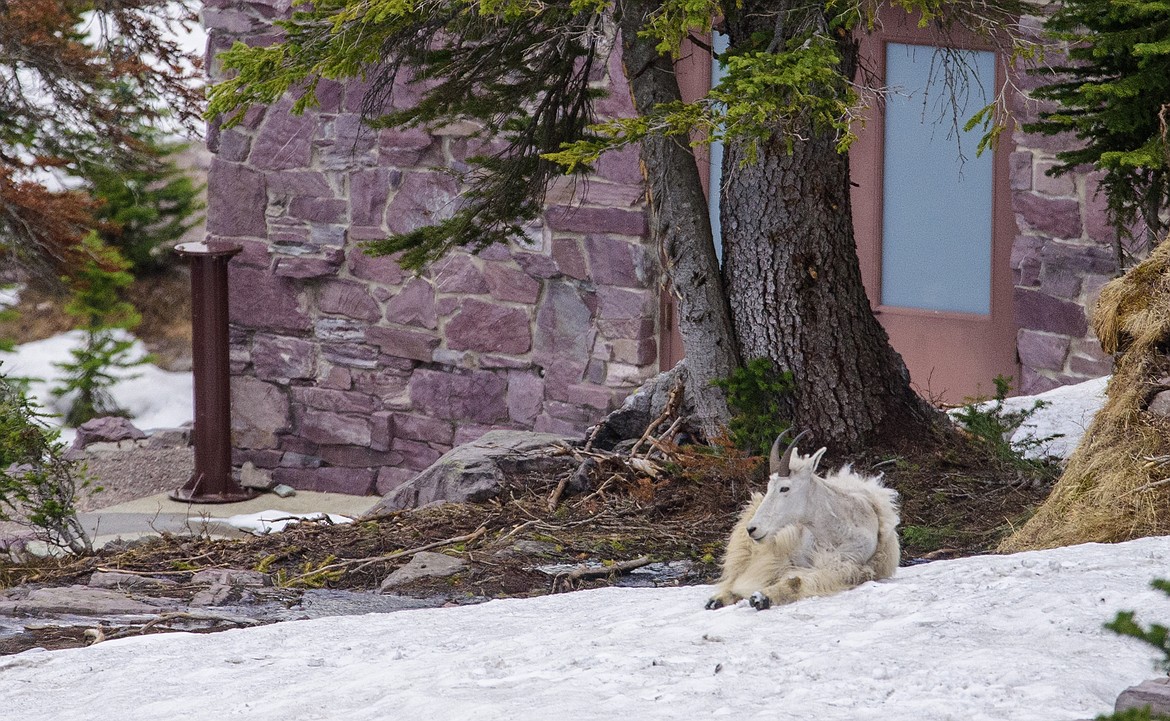For Glacier’s iconic goats, snow proves solace from bugs
A big snowfield in Glacier National Park might look like a great place to cool off in the heat of summer, and plenty of mountain goats are drawn to them.
But research by scientists Forest P. Hayes and Joel Berger found that goats aren’t heading for the snow to cool off — they’re heading for the snow for relief from bugs.
The two made more than 1,000 observations of mountain goats on and near snow patches in Glacier and about 1,000 kilometers south on Mount Blue Sky in Colorado.
They assumed goats were heading to the snow as a place to cool off. But they didn’t find that to be the case.
“Our major hypothesis — that use of snow patches reduced thermal stress — was not supported based on measurements of respiration rate,” they found. “In contrast, the use of snow patches was strongly associated with reduced insect harassment.”
The bugs don’t hang around in the snow, it seems.
Hayes said the goats probably see some cooling relief from snow, but not as much as expected. It’s probably because the sun reflects off the bright surface and goats already have a thick coat of fur, which insulates them from the cold.
In an interview last week, Hayes said the findings came as a surprise. An earlier study in Glacier found that goats breathed a bit easier when they were around snowfields, but this study took a much broader and in-depth sample and found that wasn’t really the case.
Hayes said they didn’t identify the exact insects causing the goats to use snowfields. The study was done non-invasively using Canon cameras and long telephoto lenses in order not to disturb the goats.
Goats were typically a long way away — more than 200 meters. Researchers could still see they were flies — as ear twitching a clear sign of being harassed by biting flies.
Identifying the insects could, however, come in a later study, Hayes noted.
“It would be something really interesting to look at,” he said.
The results are important because with climate change high elevations are seeing warming rates at two to five times the Earth’s average.
“Warming temperatures are bringing a lot of challenges,” to animal species that live in alpine terrain, noted longtime researcher, scientist and co-author Joel Berger.
Last summer, for example, the snow melt came early in Glacier and areas where goats might find snowfields that persisted well into summer were bare by June.
“Some of our cherished species are going to change in distribution under the onslaught of climate change and the (impacts) it brings with it,” Berger said.
The paper notes that mountain goats once roamed as far south as Texas and one species even lived in Mexico.
Insects have been known to cause declines in other animal populations, most notably moose. Winter ticks in moose in the Northeast have decimated some moose populations as the animals spend enormous amounts of energy trying to rid themselves of the blood-sucking pests. The end result is a high mortality rate of moose calves, which simply don’t have the means to deal with all the ticks. Some moose may have as many as 40,000 ticks on their bodies.
The snowfields aren’t the end-all to avoid insects for goats, Hayes notes.
They can often get to higher and rocky terrain where the wind blows and bugs aren’t so persistent.
“This isn’t to say there aren’t ways to avoid insects,“ Hayes noted. “It (snowfields) are just a good way.”
The goats don’t even stay on the snow that long, just long enough to get some bug relief. Most stayed about 15 minutes to a half hour, Hayes said.
Still, disappearing snowfields and disappearing glaciers in the park are a reason for concern. It’s been well-documented in Glacier that the habitat for the iconic animals is changing. Places that were once open meadows for summer grazing are now forested as the treeline advances upward in the park due to climate change. With more vegetation, there could very well be more bugs to bite the goats.
And with a warming world, fewer snowfields to find refuge.


